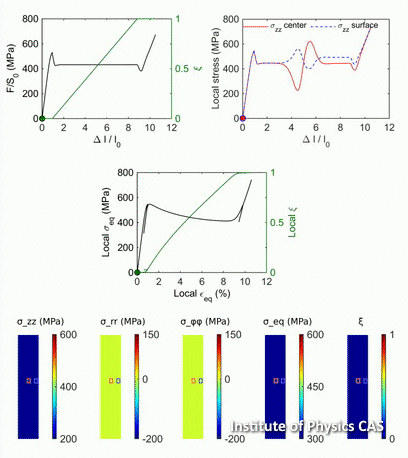You are here
FE simulation of localized deformation in tensioned NiTi wire
Simulation of localized deformation of NiTi wire by FE implemented SMA model.

Figure 1: Simulation of the localized deformation of NiTi wire during forward loading in tension by FE implemented SMA model.
- Upper left figure shows evolution of macroscopic superelastic force-elongation and martensite phase fraction - elongation responses
- Upper right figure shows evolution of axial stress component and phase fraction in two different material points (Center, Surface) with the macrosopic elongation.
- Middle figure shows local constitutive equivalent stress - equivalent strain and local martensite phase fraction - equivalent strain response in a denoted material point (Surface) in the time basis of the simulation. The local constitutive response is nevertheless the same in each material point of the wire.
- Bottom figure shows evolution of simulated components of macroscopic internal stress field in cyclindrical coordinates and phase fraction field xsi. In order to create a “wire like image” of the stress field, two plots are stitched together in mirror symmetry. Two material points (Center, Surface), in which local tensile stress component and constitutive response response, are denoted by squares.
The Martensite Band Front was artificially nucleated at the bottom end by locally decreasing the otherwise constant test temperature. The nucleation event gives rise to the overpeak on the macroscopic stress-strain curve.
The wire is elongated ~1% in austenite state prior and ~10% in martensite state after the propagating front.
To be noted
Localized deformation of NiTi wire via martensitic transformation is a macroscopic mechanical phenomenon originating from the softenning constitutive behavior of polycrystalline NiTi loaded in tension assumed in the modelling.
There are internal stress gradients associated with the propagating Martensite Band Front - i.e. before the material starts to transform the stress state changes from uniaxial tensile to multiaxial stress characterized by elevated radial compression and shear
The Martensite Band Front propagates at constant force yielding the transformation plateau 425 MPa but locally the austenite transforms to martensite at ~580 MPa equivalent stress.
The temporary increase/decrease of tensile stress component on the surface at the propagation front with its strain gradient is expected to worsen fatigue performance of NiTi wires cycled in tension.
The simulated macroscopic internal stress evolves differently in different material points (Center, Surface) - i.e. grains located in different parts of the wire transform under different sequences of stress states. This naturally affects martensitic microstructures forming in the center and surface of the tensioned wire. Note that axial and equivalent stresses in the martensite band are higher on the wire surface.
Take away
Simulation of localized deformation of NiTi wire by FE implemented SMA model supports the view that the localized deformation of polycrystalline NiTi in tension originates from the softenning constitutive behavior.
The simulated stress, strain and phase fraction fields correspond reasonably well to their counterparts determined in the static 3D-XRD experiment
Rychlé odkazy
Copyright © 2015 OFM AV ČR, v. v. i.
